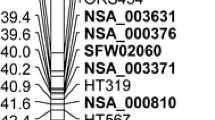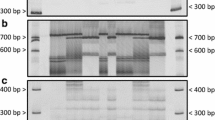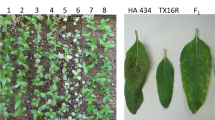Abstract
Sunflower oil is one of the major sources of edible oil. As the second largest hybrid crop in the world, hybrid sunflowers are developed by using the PET1 cytoplasmic male sterility system that contributes to a 20 % yield advantage over the open-pollinated varieties. However, sunflower production in North America has recently been threatened by the evolution of new virulent pathotypes of sunflower rust caused by the fungus Puccinia helianthi Schwein. Rf ANN-1742, an ‘HA 89’ backcross restorer line derived from wild annual sunflower (Helianthus annuus L.), was identified as resistant to the newly emerged rust races. The aim of this study was to elucidate the inheritance of rust resistance and male fertility restoration and identify the chromosome location of the underlying genes in Rf ANN-1742. Chi-squared analysis of the segregation of rust response and male fertility in F2 and F3 populations revealed that both traits are controlled by single dominant genes, and that the rust resistance gene is closely linked to the restorer gene in the coupling phase. The two genes were designated as R 11 and Rf5, respectively. A set of 723 mapped SSR markers of sunflower was used to screen the polymorphism between HA 89 and the resistant plant. Bulked segregant analysis subsequently located R 11 on linkage group (LG) 13 of sunflower. Based on the SSR analyses of 192 F2 individuals, R 11 and Rf5 both mapped to the lower end of LG13 at a genetic distance of 1.6 cM, and shared a common marker, ORS728, which was mapped 1.3 cM proximal to Rf5 and 0.3 cM distal to R 11 (Rf5/ORS728/R 11 ). Two additional SSRs were linked to Rf5 and R 11 : ORS995 was 4.5 cM distal to Rf5 and ORS45 was 1.0 cM proximal to R 11 . The advantage of such an introduced alien segment harboring two genes is its large phenotypic effect and simple inheritance, thereby facilitating their rapid deployment in sunflower breeding programs. Suppressed recombination was observed in LGs 2, 9, and 11 as it was evident that no recombination occurred in the introgressed regions of LGs 2, 9, and 11 detected by 5, 9, and 22 SSR markers, respectively. R 11 is genetically independent from the rust R-genes R 1 , R 2 , and R 5 , but may be closely linked to the rust R-gene R adv derived from wild Helianthus argophyllus, forming a large rust R-gene cluster of R adv /R 11 /R 4 in the lower end of LG13. The relationship of Rf5 with Rf1 is discussed based on the marker association analysis.





Similar content being viewed by others
References
Abratti G, Bazzalo ME, León A (2008) Mapping a novel fertility restoration gene in sunflower. In: Proceedings of the 17th international sunflower conference, Córdoba, 8–12 June 2008, pp 617–621
Bachlava E, Radwan OE, Abratti G, Tang S, Gao W, Heesacker AF, Bazzalo ME, Zambelli A, Leon AJ, Knapp SJ (2011) Downy mildew (Pl 8 and Pl 14 ) and rust (R Adv ) resistance genes reside in close proximity to tandemly duplicated clusters of non-TIR-like NBS-LRR-encoding genes on sunflower chromosomes 1 and 13. Theor Appl Genet 122:1211–1221
Berry ST, Leon AJ, Peerbolte R, Challis C, Livini C, Jones R, Feingold S (1997) Presentation of the Advanta sunflower RFLP linkage map for public research. In: Proceedings of the 19th sunflower research workshop, Fargo, 9–10 Jan 1997, pp 113–118
Bert P, Tourvieille de Labrouhe D, Philippon J, Mouzeyar S, Jouan I, Nicolas P, Vear F (2001) Identification of a second linkage group carrying genes controlling resistance to downy mildew (Plasmopara halstedii) in sunflower (Helianthus annuus L.). Theor Appl Genet 103:992–997
Burke JM, Tang S, Knapp SJ, Rieseberg LH (2002) Genetic analysis of sunflower domestication. Genetics 161:1257–1267
Burke JM, Lai Z, Salmaso M, Nakazato T, Tang S, Heesacker A, Knapp SJ, Rieseberg LH (2004) Comparative mapping and rapid karyotypic evolution in the genus Helianthus. Genetics 167:449–457
Chandler JM, Jan CC, Beard BH (1986) Chromosomal differentiation among the annual Helianthus species. Syst Bot 11:354–371
de Romano AB, Vázquez AN (2003) Origin of the Argentine sunflower varieties. Helia 26:127–136
Ellis JG, Lawrence G, Ayliffe M, Anderson P, Collins N et al (1997) Advances in the molecular genetic analysis of the flax–flax rust interaction. Annu Rev Phytopathol 35:271–291
Feng J, Jan CC (2008) Introgression and molecular tagging of Rf4, a new male fertility restoration gene from wild sunflower Helianthus maximiliani L. Theor Appl Genet 117:241–249
Gentzbittel L, Vear F, Zhang YX, Berville A (1995) Development of a consensus linkage RFLP map of cultivated sunflower (Helianthus annuus L.). Theor Appl Genet 90:1079–1086
Gentzbittel L, Mestries E, Mouzeyar S, Mazeyrat F, Badaoui S, Vear F, Tourvieille De Labrouhe D, Nicolas P (1999) A composite map of expressed sequences and phenotypic traits of the sunflower (Helianthus annuus L.) genome. Theor Appl Genet 99:218–234
Goulter KC (1990) Breeding of a rust differential sunflower line. In: Proceedings of the 8th Australian sunflower association workshop, Toowoomba, 19–22 Mar 1990, pp 120–124
Gulya TJ (1985) Registration of five disease-resistant sunflower germplasms. Crop Sci 25:719–720
Gulya TJ (2006) The sunflower rust situation: current races in the northern and central Great Plains, and resistance in oilseed and confection hybrids. In: Proceedings of the 28th sunflower research workshop, Fargo, 11–12 Jan 2006. http://www.sunflowernsa.com/research/research-workshop/documents/Gulya_Rust_06.pdf
Gulya TJ, Markell S (2009) Sunflower rust status—2008. Race frequency across the midwest and resistance among commercial hybrids. http://www.sunflowernsa.com/uploads/Gulya_RustStatus_09.pdf
Gulya TJ, Masirevic S (1996) Inoculation and evaluation methods for sunflower rust. In: Proceedings of the 18th sunflower research workshop, Fargo, 11–12 Jan 1996, pp 31–38
Gulya TJ, Viranyi F (1994) Virulent new races of sunflower rust (Puccinia helianthi) from the southern Great Plains. In: Proceedings of the 16th sunflower research workshop, Fargo, 13–14 Jan 1994, pp 94–98
Gulya TJ, Venette R, Venette JR, Lamey HA (1990) Sunflower rust. NDSU Ext. Ser. Bull., Fargo, p 998. http://www.ag.ndsu.edu/pubs/plantsci/rowcrops/pp998w.htm
Heiser CB Jr (1954) Variation and subspeciation in the common sunflower, Helianthus annuus. Am Midl Nat 51:287–305
Horn R, Kusterer B, Lazarescu E, Prufe M, Friedt W (2003) Molecular mapping of the Rf1 gene restoring pollen fertility in PET1-based F1 hybrids in sunflower (Helianthus annuus L.). Theor Appl Genet 106:599–606
Horne EC, Kumpatla SE, Patterson KA, Gupta M, Thompson SA (2004) Improved high-throughput sunflower and cotton genomic DNA extraction and PCR fidelity. Plant Mol Biol Rep 22:83–84
Hulbert SH, Webb CA, Smith SM, Sun Q (2001) Resistance gene complexes: evolution and utilization. Ann Rev Phytopathol 39:285–312
Islam MR, Shepherd KW (1991) Present status of genetics of rust resistance in flax. Euphytica 55:255–267
Jan CC, Vick BA (2007) Inheritance and allelic relationships of fertility restoration genes for seven new sources of male-sterile cytoplasm in sunflower. Plant Breed 126:213–217
Jones DA, Dickinson MJ, Balint-Kurti PJ, Dixon MS, Jones JDG (1993) Two complex resistance loci revealed in tomato by classical and RFLP mapping of the Cf-2, Cf-4, Cf-5, and Cf-9 genes for resistance to Cladosporium fulvum. Mol Plant Microbe Int 6:348–357
Kinman ML (1970) New development in the USDA and state experiment station sunflower breeding programs. In: Proceedings of the 4th international sunflower conference, Memphis, 23–25 June 1970, pp 181–183
Korell M, Mösges G, Friedt W (1992) Construction of a sunflower pedigree map. Helia 15:7–16
Kosambi DD (1944) The estimation of map distances from recombination values. Ann Eugen 12:172–175
Kusterer B, Horn R, Friedt W (2005) Molecular mapping of the fertility restoration locus Rf1 in sunflower and development of diagnostic markers for the restorer gene. Euphytica 143:35–42
Lambrides CJ, Miller JF (1994) Inheritance of rust resistance in a source of MC29 sunflower germplasm. Crop Sci 34:1225–1230
Lander ES, Green P, Abrahamson J, Barlow A, Daly MJ, Lincoln SE, Newburg L (1987) MAPMAKER: an interactive computer package for constructing primary genetic maps of experimental and natural population. Genomics 1:174–181
Lawson WR, Goulter KC, Henry RJ, Kong GA, Kochman JK (1998) Marker assisted selection for two rust resistance genes in sunflower. Mol Breed 4:227–234
Lawson WR, Jan CC, Shatte T, Smith L, Kong GA, Kochman JK (2011) DNA markers linked to the R 2 rust resistance gene in sunflower (Helianthus annuus L.) facilitate anticipatory breeding for this disease variant. Mol Breed 28:569–576. doi:10.1007/s11032-010-9506-1
Leclercq P (1969) Une stérilité male cytoplasmique chez letournesol. Ann Amélior Plant 19:99–106
Liu Z, Mulpuri S, Feng J, Vick BA, Jan CC (2011) Molecular mapping of the Rf3 fertility restoration gene to facilitate its utilization in breeding confection sunflower. Mol Breed. doi:10.1007/s11032-011-9563-0
Mazeyrat F, Mouzeyar S, Nicolas P, Tourvieille de Labrouhe D, Ledoigt G (1998) Cloning, sequence and characterization of a sunflower (Helianthus annuus L.) pathogen-induced gene showing sequence homology with auxin-induced genes from plants. Plant Mol Biol 38:899–903
Miah MAJ, Sackston WE (1970) Genetics of host-pathogen interaction in sunflower. Phytoprotection 51:1–16
Michelmore RW, Meyers BC (1998) Clusters of resistance genes in plants evolve by divergent selection and a birth-and-death process. Genome Res 8:1113–1130
Michelmore RW, Paran I, Kesseli RV (1991) Identification of markers linked to disease-resistance genes by bulked segregant analysis: a rapid method to detect markers in specific genomic regions by using segregating populations. Proc Natl Acad Sci USA 88:9828–9832
Miller JF, Gulya TJ (1988) Registration of six downy mildew resistant sunflower germplasm lines. Crop Sci 28:1040–1041
Miller JF, Gulya TJ (2001) Registration of three rust resistant sunflower germplasm populations. Crop Sci 41:601
Miller JF, Rodriguez RH, Gulya TJ (1988) Evaluation of genetic materials for inheritance of resistance to race 4 rust in sunflower. In: Proceedings of the 12th international sunflower conference, Novi Sad, 25–29 July 1988, pp 361–365
Putt ED, Sackston WE (1963) Studies on sunflower rust. IV. Two genes, R 1 and R 2 for resistance in the host. Can J Plant Sci 43:490–496
Qi LL, Gulya TJ, Seiler GJ, Hulke BS, Vick BA (2011a) Identification of resistance to new virulent races of rust in sunflowers and validation of DNA markers in the gene pool. Phytopathol 101:241–249
Qi LL, Hulke BS, Vick BA, Gulya TJ (2011b) Molecular mapping of the rust resistance gene R 4 to a large NBS-LRR cluster on linkage group 13 of sunflower. Theor Appl Genet 123:351–358. doi:10.1007/s00122-011-1588-6
Qi LL, Gulya TJ, Hulke BS, Vick BA (2011c) Chromosome location, DNA markers and rust resistance of the sunflower gene R 5 . Mol Breed. doi:10.1007/s11032-011-9659-6
Radwan O (2010) Isolation and expression of an NBS-LRR protein-encoding resistance gene candidate that segregates with a rust resistance gene in sunflower. J Phytopathol 158:433–443
Radwan O, Bouzidi MF, Vear F, Philippon J, de Labrouhe DT, Nicolas P, Mouzeyar S (2003) Identification of non-TIR-NBS-LRR markers linked to Pl5/Pl8 locus for resistance to downy mildew in sunflower. Theor Appl Genet 106:1438–1446
Radwan O, Gandhi S, Heesacker A, Whitaker B, Taylor C, Plocik A, Kesseli R, Kozik A, Michelmore RW, Knapp SJ (2008) Genetic diversity and genomic distribution of homologs encoding NBS-LRR disease resistance proteins in sunflower. Mol Genet Genomics 280:111–125
Rashid KY (2006) Sunflower rust races in Manitoba. http://www.umanitoba.ca/afs/agronomists_conf/proceedings/2006/Rashid_sunflower_rust_races.pdf
Richter TE, Ronald PC (2000) The evolution of disease resistance genes. Plant Mol Biol 42:195–204
Salmeron JM, Oldroyd GE, Rommens CM, Scofield SR, Kim HS et al (1996) Tomato Prf is a member of the leucine-rich repeat class of plant disease resistance genes and lies embedded within the Pto kinase gene cluster. Cell 86:123–133
Saxena KMS, Hooker AL (1968) On the structure of a gene for disease resistance in maize. Proc Natl Acad Sci USA 61:1300–1305
Saxena KMS, Hooker AL (1974) A study on the structure of gene Rp3 for rust resistance in Zea mays. Can J Genet Cytol 16:857–860
Seiler GJ, Jan CC (1994) New fertility restoration genes from wild sunflowers for sunflower PET1 male-sterile cytoplasm. Crop Sci 34:1526–1528
Seiler GJ, Jan CC (1997) Registration of 10 interspecific germplasm fertility restoration populations for sunflower PET1 male-sterile cytoplasm. Crop Sci 37:1989–1991
Sendall BC, Kong GA, Goulter KC, Aitken EAB, Thompson SM, Mitchell JHM, Kochman JK, Lawson W, Shatte T, Gulya TJ (2006) Diversity in the sunflower: Puccinia helianthi pathosystem in Australia. Australas Plant Pathol 35:657–670
Slabaugh MB, Yu JK, Tang SX, Heesacker A, Hu X, Lu GH, Bidney D, Han F, Knapp SJ (2003) Haplotyping and mapping a large cluster of downy mildew resistance gene candidates in sunflower using multilocus intron fragment length polymorphisms. Plant Biotech J 1:167–185
Song WY, Pi LY, Wang GL, Gardner J, Holsten T et al (1997) Evolution of the rice Xa21 disease resistance gene family. Plant Cell 9:1279–1287
Tang S, Yu JK, Slabaugh MB, Shintani DK, Knapp SJ (2002) Simple sequence repeat map of the sunflower genome. Theor Appl Genet 105:1124–1136
Tang S, Kishore VK, Knapp SJ (2003) PCR-multiplexes for a genome-wide framework of simple sequence repeat marker loci in cultivated sunflower. Theor Appl Genet 107:6–19
Wei F, Gobelman-Werner K, Morroll SM, Kurth J, Mao L, Wing R, Leister D, Schulze-Lefert P, Wise RP (1999) The Mla (powdery mildew) resistance cluster is associated with three NBS-LRR gene families and suppressed recombination within a 240-kb DNA interval on chromosome 5S (1HS) of barley. Genetics 153:1929–1948
Yang SM, Antonelli EF, Luciano A, Luciani ND (1986) Reactions of Argentine and Australian sunflower rust differentials to four North American cultures of Puccinia helianthi from North Dakota. Plant Dis 70:883–886
Yang SM, Dowler WM, Luciano A (1989) Gene Pu 6 : a new gene in sunflower for resistance to Puccinia helianthi. Phytopathology 79:474–477
Yu JK, Tang S, Slabaugh MB, Heesacker A, Cole G et al (2003) Towards a saturated molecular genetic linkage map for cultivated sunflower. Crop Sci 43:367–387
Yue B, Vick BA, Cai X, Hu J (2010) Genetic mapping for the Rf1 (fertility restoration) gene in sunflower (Helianthus annuus L.) by SSR and TRAP markers. Plant Breed 129:24–28
Acknowledgments
We thank Drs. Xiwen Cai and Zengcui Zhang for critical review of the manuscript, and Angelia Hogness and Hannah Worral for technical assistance. This project was supported by the USDA-ARS CRIS Project No. 5442-21000-034-00D.
Author information
Authors and Affiliations
Corresponding author
Additional information
Communicated by A. Bervillé.
Mention of trade names or commercial products in this article is solely for the purpose of providing specific information and does not imply recommendation or endorsement by the US Department of Agriculture.
Rights and permissions
About this article
Cite this article
Qi, L.L., Seiler, G.J., Vick, B.A. et al. Genetics and mapping of the R 11 gene conferring resistance to recently emerged rust races, tightly linked to male fertility restoration, in sunflower (Helianthus annuus L.). Theor Appl Genet 125, 921–932 (2012). https://doi.org/10.1007/s00122-012-1883-x
Received:
Accepted:
Published:
Issue Date:
DOI: https://doi.org/10.1007/s00122-012-1883-x




